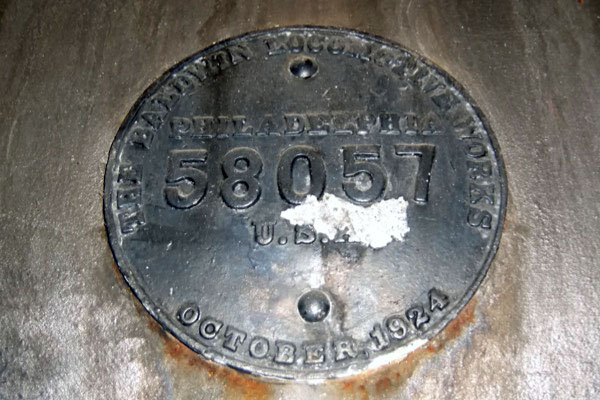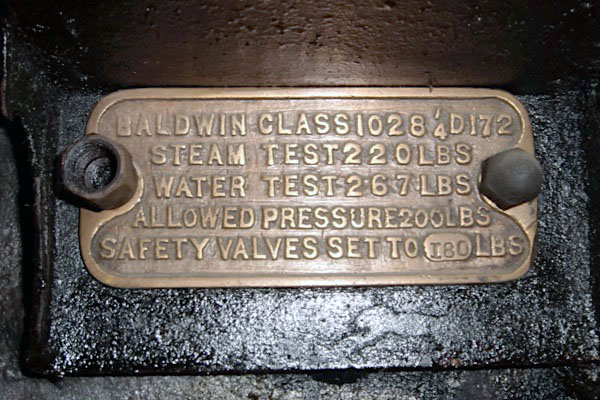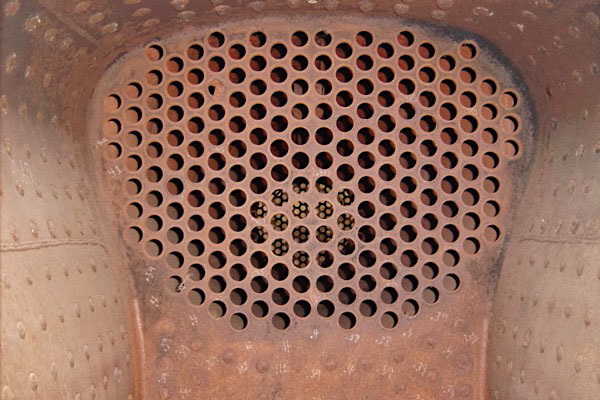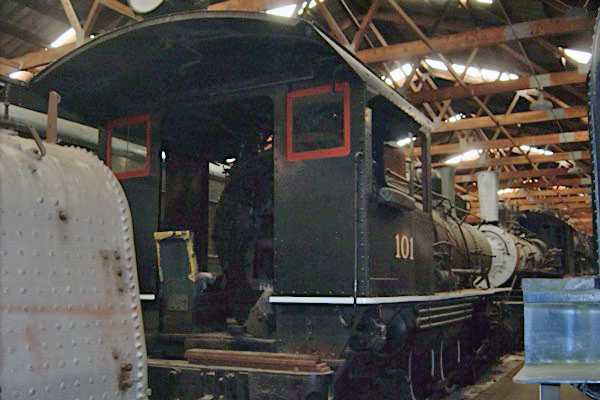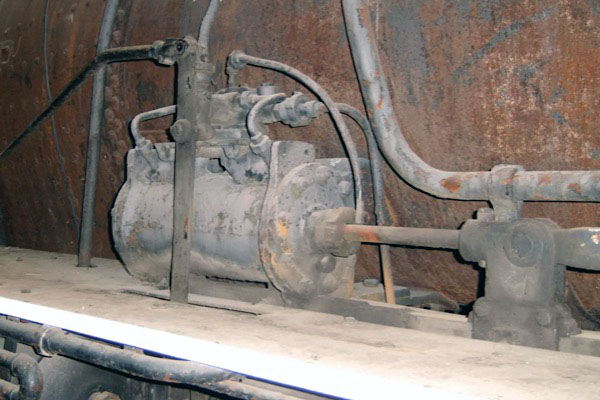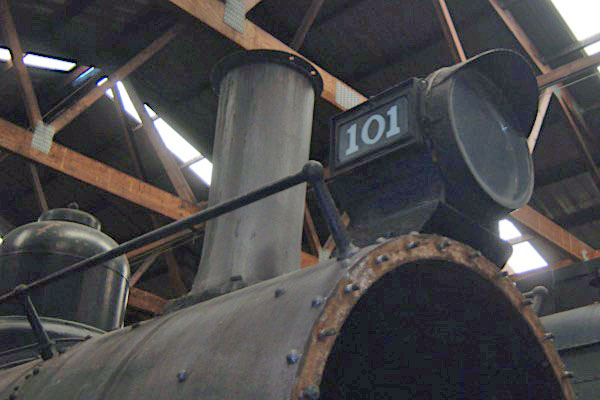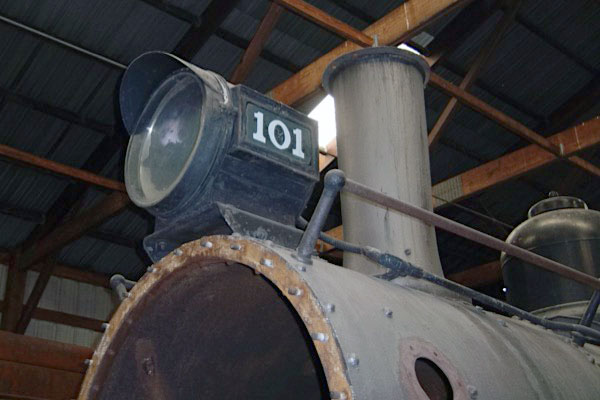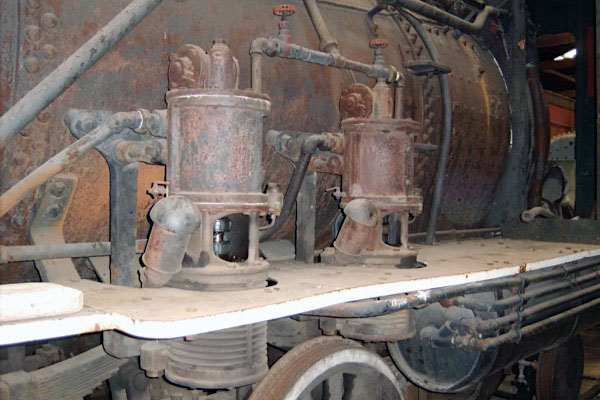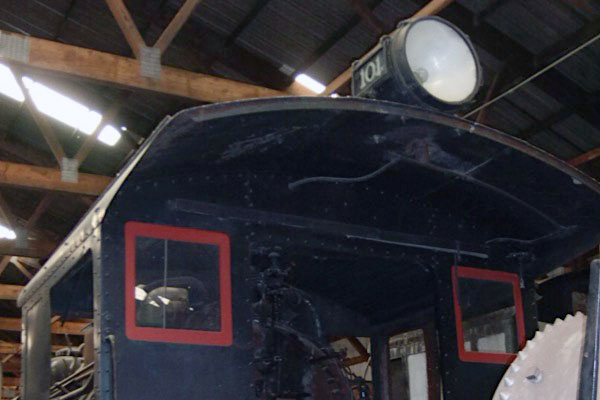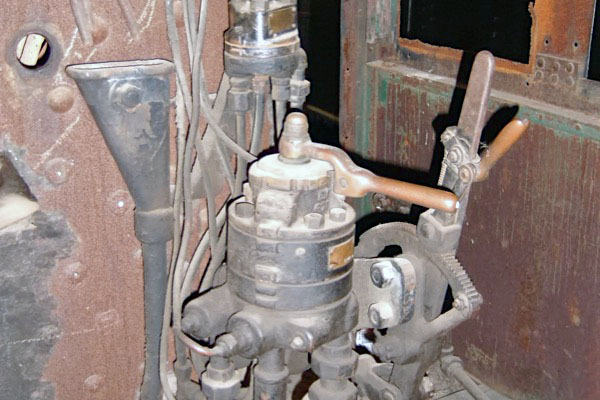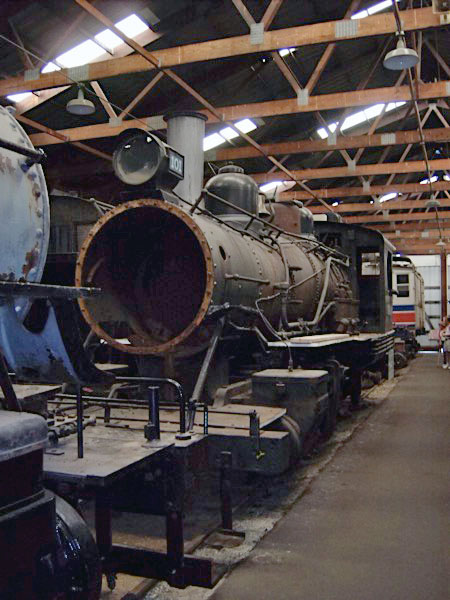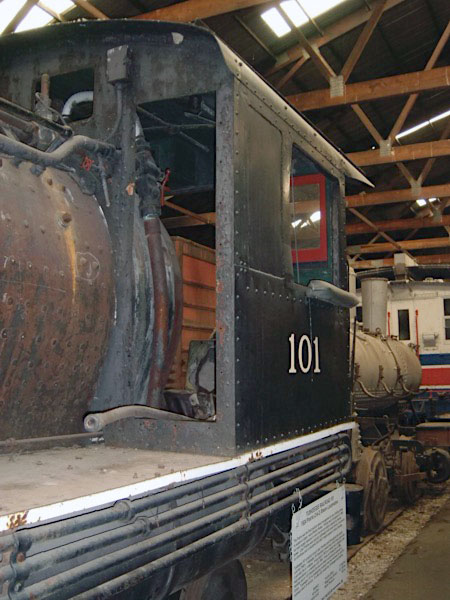
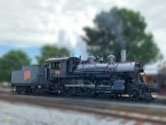

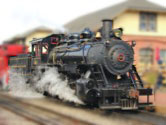




Steam
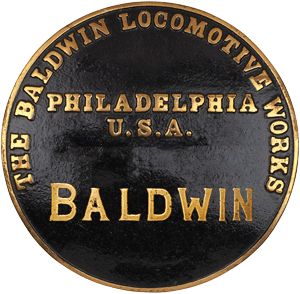 |
Tuskegee #101A Deep South Prairie Retires Up North |
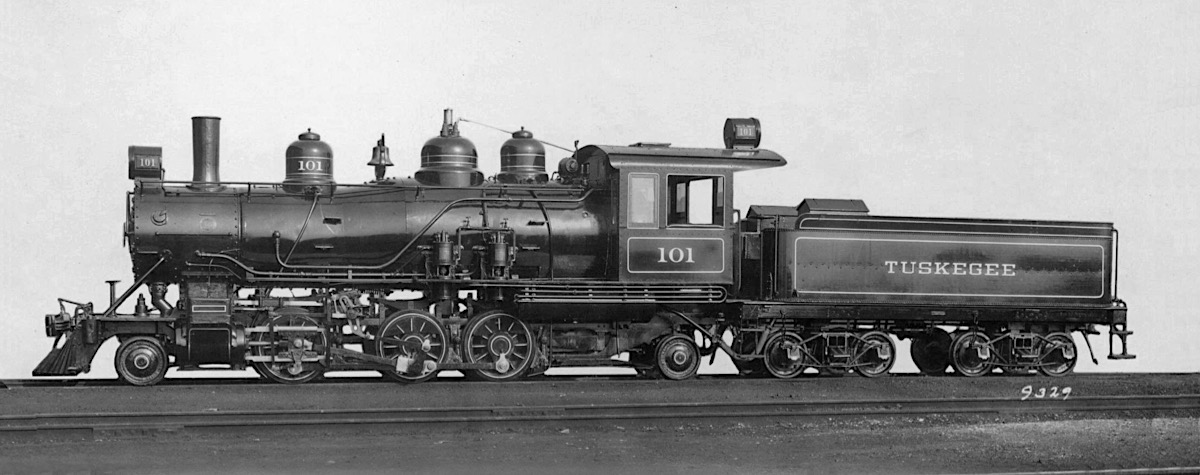
Baldwin builders photo / Charles Johns Jr. collection
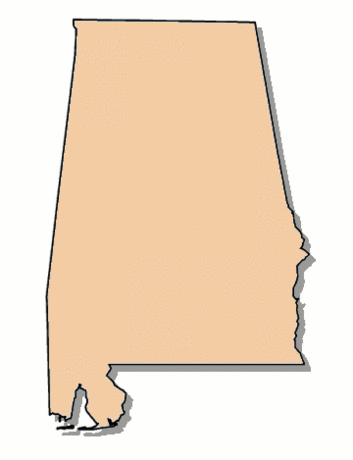
 uskegee #101 is a handsome, small-drivered Prairie-type steam locomotive built by Baldwin Locomotive Works in 1924. Baldwin factory #58057, the steamer was built for the Tuskegee Railroad -- an eastern Alabama shortline connecting the famous Tuskegee Institute with a Western Railway of Alabama mainline and therefore the rest of the continent. After years of mixed train service on the 6 mile Tuskegee, #101 was sold to south Alabama forest mill T. R. Miller. In Brewton, the Prairie joined a rare Baldwin Columbian type in shunting cars around and between the mill's two facilities connected by rail. #101 become a railfan favorite in the Deep South, a rare revenue steamer still in service at the end of the steam-to-diesel transition era. When a diesel finally landed at the mill, veteran #101 was purchased by the president of the growing Illinois Railway Museum in suburban Chicago. In Illinois, #101 was re-lettered for her original owner and found a third act hauling museum visitors on the excursion tracks, occasionally double-heading with other smaller kettles in the collection. Eventually, more life could not be coxed out of her worn-out boiler and leaking tubes. The locomotive was stored serviceable in one of the museum's many exhibit barns, where it remains today.
uskegee #101 is a handsome, small-drivered Prairie-type steam locomotive built by Baldwin Locomotive Works in 1924. Baldwin factory #58057, the steamer was built for the Tuskegee Railroad -- an eastern Alabama shortline connecting the famous Tuskegee Institute with a Western Railway of Alabama mainline and therefore the rest of the continent. After years of mixed train service on the 6 mile Tuskegee, #101 was sold to south Alabama forest mill T. R. Miller. In Brewton, the Prairie joined a rare Baldwin Columbian type in shunting cars around and between the mill's two facilities connected by rail. #101 become a railfan favorite in the Deep South, a rare revenue steamer still in service at the end of the steam-to-diesel transition era. When a diesel finally landed at the mill, veteran #101 was purchased by the president of the growing Illinois Railway Museum in suburban Chicago. In Illinois, #101 was re-lettered for her original owner and found a third act hauling museum visitors on the excursion tracks, occasionally double-heading with other smaller kettles in the collection. Eventually, more life could not be coxed out of her worn-out boiler and leaking tubes. The locomotive was stored serviceable in one of the museum's many exhibit barns, where it remains today.
HawkinsRails thanks Charles Johns Jr. and Bob Albertson for use of their 101 photos and narrative

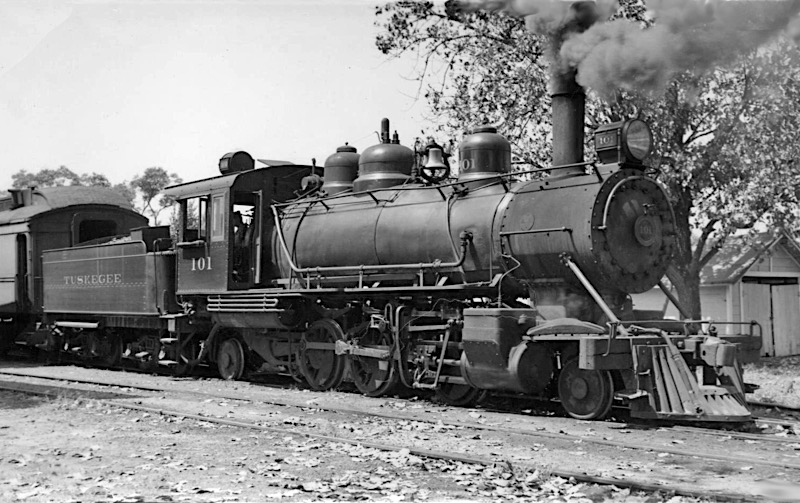
Tuskegee #101
Tuskegee, Al / Charles Johns Jr. collection


Tuskegee #101
to T R Miller Mill Company #101
sold to Illinois Railway Museum
cosmetically restored as Tuskegee #101
stored serviceable at IRM


See also our Tuskegee Railroad collection in Shortlines

Brewton, Al / Feb 1961 / JCH
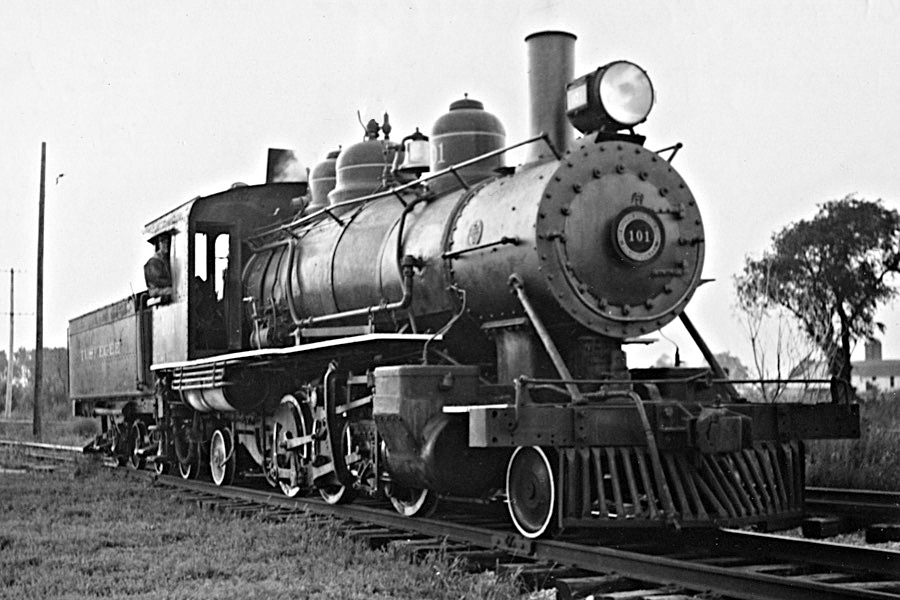
Union, Il / 1971 / Bob Albertson collection
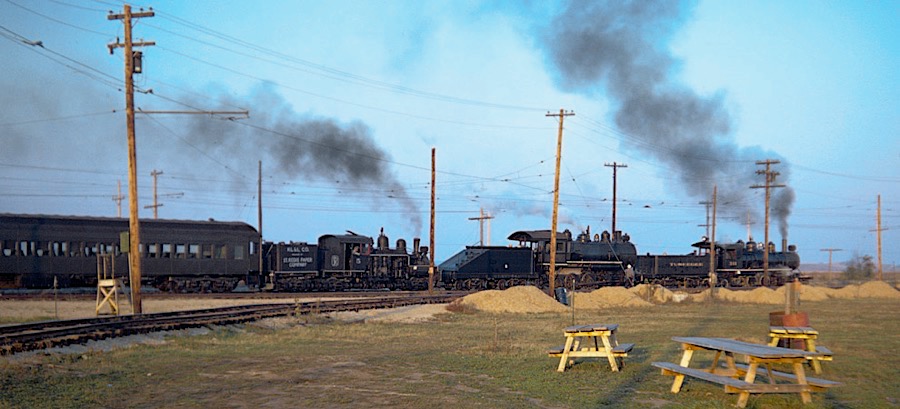
Union, Il / Bob Albertson collection
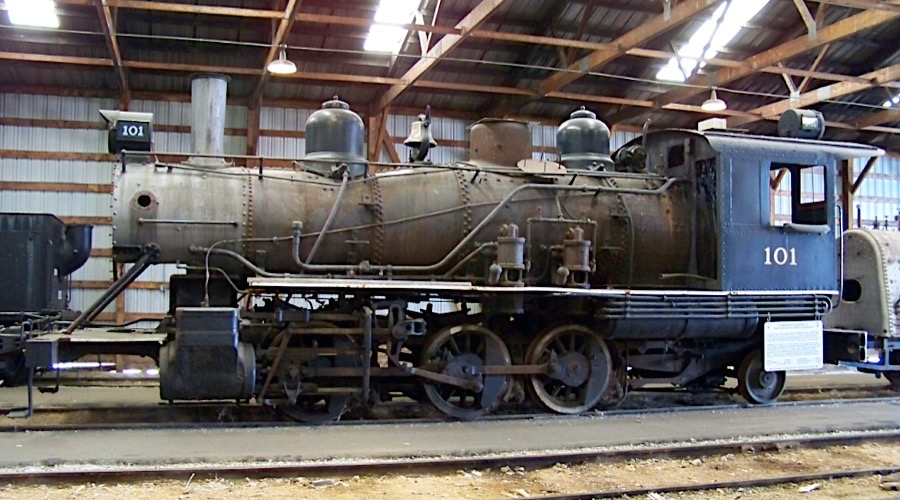
Union, Il / Aug 2010 / Tim Fennell
 Article
Article
SWEET HOME ALABAMA
January 2018
Tuskegee RR #101, with its Alabama pedigree, is a soft spoken southern engine. The diminutive 2-6-2 Prairie type locomotive was built in 1924 by the Baldwin Locomotive Company at Eddystone, PA as a saturated steam coal burner for the Tuskegee RR with a $21,250 price tag.
At the time of its purchase, it joined a roster that included 1903 Baldwin 4-4-0 #6 and 1905 Rogers 2-6-0 #7 on the 5.7 mile line from Tuskegee north to the interchange with the Montgomery & West Point RR at Chehaw, AL. The first two miles out of Tuskegee were in the valley of a small stream. The rest of the run to Chehaw was gently upgrade.
 The Tuskegee RR was incorporated in 1860, and was built that year to 60" gauge with the labor of 500 slaves from nearby plantations. It didn't operate for long since 30 miles of the Montgomery & West Point RR to the Chehaw Station were destroyed by Major General Lovell Rousseau's Union soldiers during their raid on the Montgomery area in July 1864. The main objective was achieved as the track, bridges and stations were laid to waste. The raid curtailed the ability of the South to resupply Atlanta during the siege of Atlanta that also occurred during this time frame. The rails of the Tuskegee RR itself were melted down by the Confederates for armaments.
The Tuskegee RR was incorporated in 1860, and was built that year to 60" gauge with the labor of 500 slaves from nearby plantations. It didn't operate for long since 30 miles of the Montgomery & West Point RR to the Chehaw Station were destroyed by Major General Lovell Rousseau's Union soldiers during their raid on the Montgomery area in July 1864. The main objective was achieved as the track, bridges and stations were laid to waste. The raid curtailed the ability of the South to resupply Atlanta during the siege of Atlanta that also occurred during this time frame. The rails of the Tuskegee RR itself were melted down by the Confederates for armaments.
Post war, the rights to the railroad were bought at a sheriff's sale by developers in 1869 and the Tuskegee RR was rebuilt in 1872 to 36" gauge. The track was ballasted with gravel, cinders, and sand. The railroad had one 0-4-2T and two 0-4-4T locomotives. The interchange was still at Chehaw with the Montgomery & West Point that became the Western Rwy of Alabama. (That route eventually became CSX and is still in use today.) There was no direct interchange since the two railroads were different gauges, but that was rectified in August of 1898 when the Tuskegee RR was changed to standard gauge. (Twelve years later than the last of the major southern railroads.)
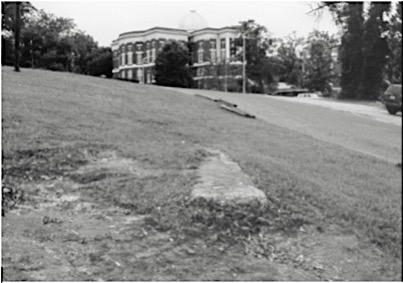 The original Tuskegee RR was built to support the town of Tuskegee, but the post-Civil War version also supported the Tuskegee Normal School for Colored Teachers. This is the reconstruction black institution that became the Tuskegee Normal & Industrial Institute and is now Tuskegee University. The Institute was established by Booker T. Washington as its first Principal in 1881. Originally built on 100 purchased acres, it now covers 2300 acres. Scientist George Washington Carver of peanut fame was one of their professors. The other claim to fame for Tuskegee was the establishment of the black pilot training center for the US Army Air Corps in 1943 at the University's School of Aviation and at nearby Moton Field. The Tuskegee Airmen became a highly decorated unit, flying fighter aircraft in Europe.
The original Tuskegee RR was built to support the town of Tuskegee, but the post-Civil War version also supported the Tuskegee Normal School for Colored Teachers. This is the reconstruction black institution that became the Tuskegee Normal & Industrial Institute and is now Tuskegee University. The Institute was established by Booker T. Washington as its first Principal in 1881. Originally built on 100 purchased acres, it now covers 2300 acres. Scientist George Washington Carver of peanut fame was one of their professors. The other claim to fame for Tuskegee was the establishment of the black pilot training center for the US Army Air Corps in 1943 at the University's School of Aviation and at nearby Moton Field. The Tuskegee Airmen became a highly decorated unit, flying fighter aircraft in Europe.
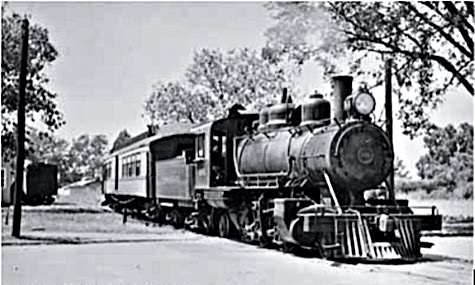 At the time #101 arrived on the property, principal freight on the line was lumber and coal for the power plant at the University. Number 101 hauled a mixed train with Tuskegee's only passenger car three times a day to the interchange in Chehaw.
At the time #101 arrived on the property, principal freight on the line was lumber and coal for the power plant at the University. Number 101 hauled a mixed train with Tuskegee's only passenger car three times a day to the interchange in Chehaw.
The 1920's were good times for the railroad, but the 1930's Great Depression hit the area hard. Truck competition was increasing. Timber shipments slumped and stopped completely in 1936. In 1939 President Roosevelt wanted to use the Tuskegee RR for a visit, but was turned down because the presidental car, Ferdinand Magellan, was too heavy for their track. Passenger service ended in 1941 because their only "Jim Crow" segregated coach wore out.
World War II brought a slight increase in traffic, but only enough to warrant 2 freight trains a week. Post war, rail traffic turned down further. Though the railroad carried on with a few of their other steam engines until abandonment in 1963, they sold #101 in 1954 to the T. R. Miller Mill Company of Brewton, AL. Once closed down, the line was quickly salvaged and little remains today of what was the Tuskegee RR. Number 101 is the only surviving piece of Tuskegee RR equipment.
When it was sold, #101 moved farther south in Alabama to work for the T.R. Miller Mill Company in Brewton, AL just across the Florida panhandle border north of Pensacola. That company started in 1848 on the banks of Cedar Creek as one of the first permanent sawmills in the South. Ownership changed to T.R. Miller in 1872 and they've been in continous business there ever since. When #101 arrived it was converted to burn oil and joined Baldwin 2-4-2T #12 on their locomotive roster.
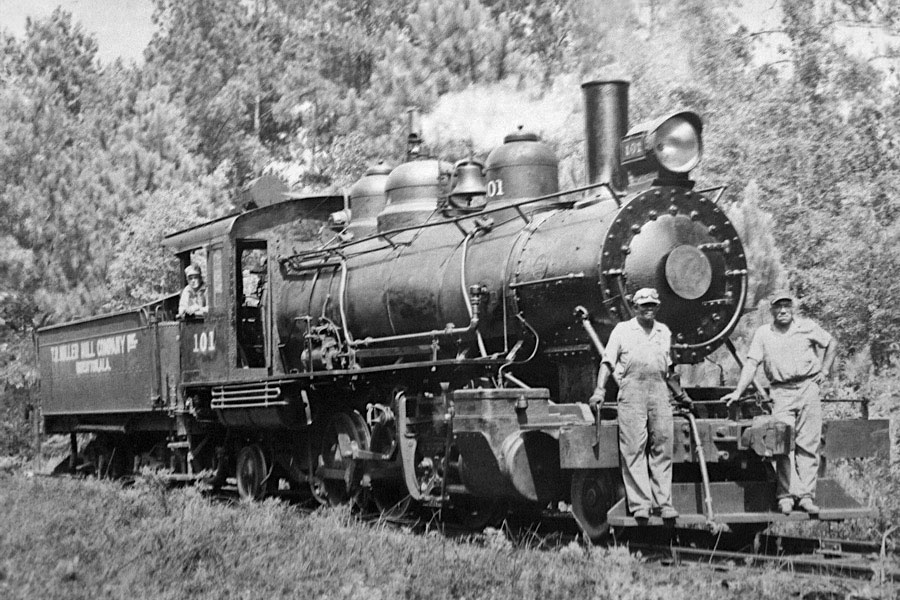 The Miller Mill company is a privately owned company that specialized in Yellow Southern Pine products. They have two mills. The first and main one produces lumber and lumber products. The second mill was added in 1927 about a mile east to produce treated poles and pilings. The two mills were linked by their railroad.
The Miller Mill company is a privately owned company that specialized in Yellow Southern Pine products. They have two mills. The first and main one produces lumber and lumber products. The second mill was added in 1927 about a mile east to produce treated poles and pilings. The two mills were linked by their railroad.
T.R. Miller has a pioneer in land and timber management. They hold the second Tree Farm certification in the US and currently manage over 215,000 acres.
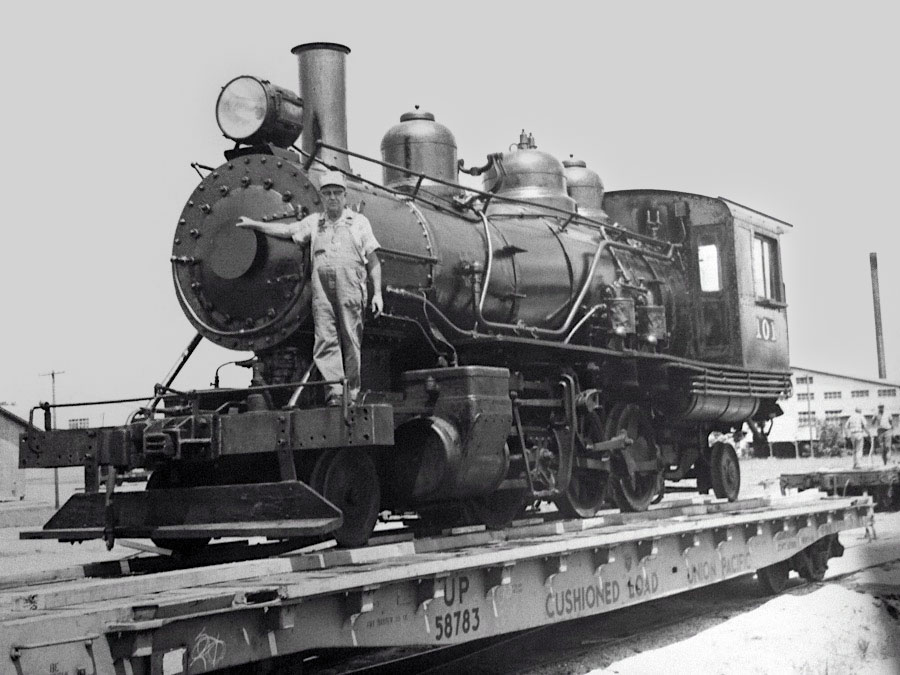 In the late 1960's T.R. Miller dieselized and in 1969 #101 was sold to then IRM president Herb Hanson. The Miller operation today uses a GE center-cab diesel.
In the late 1960's T.R. Miller dieselized and in 1969 #101 was sold to then IRM president Herb Hanson. The Miller operation today uses a GE center-cab diesel.
Arriving at IRM, #101 was put into service a year later in 1970. Herb Hanson had put his friend Fred Chambers in charge of restoring #101 to operation and he was successful. For some reason Fred disengaged and Dennis Daugherty took over care of the engine. But leaking tubes quickly sidlined the engine and the IRM steam team undertook their first major boiler repair by replacing 32 tubes and returned the engine to operation in time for the 4th of July weekend in 1971.
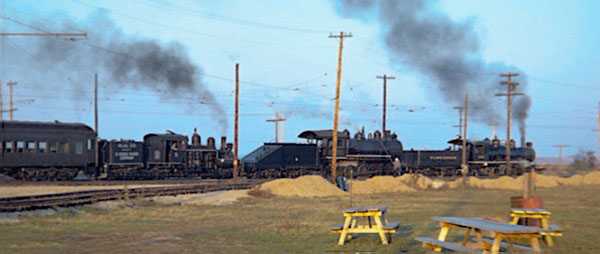 In 1971 IRM was able to run a tripple-header with Shay #5 (in steam at various times at Union since 1967), Commonwealth Edison #5 (first steamed in 1971 and another Herb Hansen purchased engine) and Tuskegee #101.
In 1971 IRM was able to run a tripple-header with Shay #5 (in steam at various times at Union since 1967), Commonwealth Edison #5 (first steamed in 1971 and another Herb Hansen purchased engine) and Tuskegee #101.
Number 101 is the only 2-6-2 Prairie tender engine in the collection. The Prairie type locomotive was an outgrowth of the 2-6-0 type, with the advantage of having a leading and trailing truck to allow it to traverse the rails equally well in either direction. This was especially helpful when the engine spent a lot of time running in reverse. (Which was the case when working on the Tuskegee and T.R. Miller. And also at IRM!)
The CB&Q and Sante Fe had the biggest fleets of 2-6-2's in the US. 2-6-2's were supposed to be somewhat unstable at higher speed, which was never a problem wherever she operated. Number 101 was a unique type on both of the small rosters for which she worked.
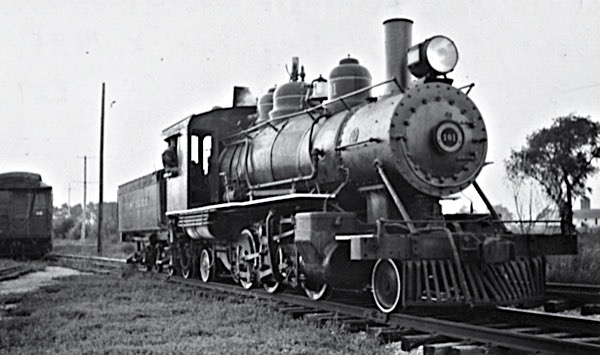 #101 operated at IRM in the 1970's and 1980's in the days before the FRA 1472 day rule went into effect (2000). At that time, the boilers were instected and certified by the State of Illinois. In most cases, boilers needed to meet ASME code or have been previously operated and certified in Illinois prior to 1951 to be re-certified by the state. The Shay had an ASME boiler so was allowed to run. The ComEd 5 ran its entire career in Illinois so was grandfathered and allowed to run. Before being sold to the Frisco, 1630 was owned by the Pennsylvania Railroad and was assigned to their Southwestern Division (Lines West) which included Illinois, so it was grandfathered and allowed to run. The 101 had an Alabama boiler ticket, but was allowed to run after negotiations with the state.
#101 operated at IRM in the 1970's and 1980's in the days before the FRA 1472 day rule went into effect (2000). At that time, the boilers were instected and certified by the State of Illinois. In most cases, boilers needed to meet ASME code or have been previously operated and certified in Illinois prior to 1951 to be re-certified by the state. The Shay had an ASME boiler so was allowed to run. The ComEd 5 ran its entire career in Illinois so was grandfathered and allowed to run. Before being sold to the Frisco, 1630 was owned by the Pennsylvania Railroad and was assigned to their Southwestern Division (Lines West) which included Illinois, so it was grandfathered and allowed to run. The 101 had an Alabama boiler ticket, but was allowed to run after negotiations with the state.
The railroads number 101 worked on were small and thus had small shops and workforces. She was pretty worn when she got to IRM, and more years of operation were coaxed out of her than could reasonably be expected. 101 was plagued constantly by leaking tubes. The oil fire was hard on the tubes. Tubes were only replacing that were needed to to keep operating, and the replacement tubes were used ones so didn't last as long as new. Often tubes around the bad tube would also be removed to make it easier to do the repairs. The Rail & Wire archives chronicle a litany of repairs over the years just to keep her going:
1972 – New rear truck wheels were installed on the tender (old were thin and had flat spots). New front foot steps. Work was done to remove pipes, sheet metal and insulation from the cab of the engine. Also insulation was removed from over the firebox outside the cab. The fire brick was removed from inside the fire box and with the entire box exposed she was hydroed and inspected. As expected several bad stay bolts were found along with a few bad tubes. Later the bad bolts and tubes were cut out. In August work was put on hold to work on CE #5. Work resumed in September with the installation of 6 new stay bolts and 12 new boiler tubes, plus replacement of the fire brick. Testing revealed more problems and they were dealt with. The air brakes valves were cleaned and tested. The engine and tender were converted from waste packing to pads in the journal boxes.
1973 – The tender was patched with several large rubber patches inside the water compartment. To help keep the tender sides together, a turnbuckle was applied between them. New valve stem packing was applied to both sides. The boiler and fire box was washed out and the throttle lapped in. The boiler tubes were cleaned. A few tubes rolled and seams were caulked. In May a spring equalizer hanger broke. After attempting to get the old part out, it was welded in place (hard to get at of course) and the next day the bar was put back in place. The main rod brasses (front and back) were removed and ends faced off to allow them to draw tight on the crank and wrist pins. Despite these problems, #101 was the main workhorse in 1973.
1974 – Most of the year was handled by CE #5 (coal burner). #101 was out of service until late in the year due to several broken stay bolts and a broken stud. The sheet metal was removed from the entire boiler for the first time at IRM, and was chipped and repainted. But this worked out okay, as with the high price of oil – we probably couldn't have afforded to run her even if we were able to get the oil. Ran on Members Day.
1976 - Twice the crosshead gib broke and was repaired. Tubes were replaced, the headlight repaired and lubricators repacked. It was back in service by Members Day to double-head with 1630 even though she didn't yet have the boiler jacket put back in place.
1977 - #101 was inspected by the State and got her operating certificate for 1977. Eight new boiler tubes were installed. Ran on Members Day.
1978 – After 2 years of seeing little service, #101 was used the first 2 months of operation. Double-headed again this year with 1630 for Members Day weekend.
1979 - Painted during 1979.
1980 – Operated on Members Day pulling a caboose train.
1982 – Welded patches on the tender and repainted the boiler.
1987 – Got new brake shoes and a new injector.
By the end of the 1980's all the tubes were removed in anticipation of the 1472 day overhaul as they could not be rolled over anymore to seal leaks. But futher inspection found that corrosion at the bottom of the smoke box was bad enough that it would necessitate a total replacement like the Shay is currently getting. Other major and expensive problems were very rusted studs on the cylinder casting making it very hard to fix, worn wheels and the fact that the running gear was worn out. The most critical issue, and the final straw that saw her removed from service, was that the crown brasses on the drive axels all needed to be replaced. By 1990 all the tubes were removed, as well as the pony truck – and it has been dissembled ever since.
#101 was a good steamer if you knew how to fire her. Dennis Daugherty figured it out and taught Dave Conrad, Phil Hehn, and Mark Secco. (Phil and Mark are still IRM steam engineers today – 2017.) Other firemen were not as successful. With the lead and trailing trucks she tracked well going in either direction on the IRM rails.
One of the problems being an oil burner is that her exhaust was directly below the trolley wire. It would be oily and foul the overhead trolley wire. Periodically the line car had to be taken out and the trolley wires wiped down to get the oil off. The oily residue may have helped to make the trolley poles glide over the wire better, but it didn't help the electrical conductivity.
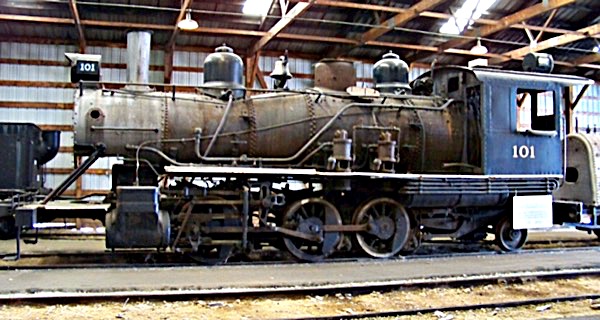 For many years she was displayed in barn 9 (minus tubes, smoke box bottom and pony truck), while the steam team devoted their efforts to 1630, the Shay and 428. The engine and tender were separated for a few years with the tender placed outside, but they were re-united and moved into Barn 14 in 2016.
For many years she was displayed in barn 9 (minus tubes, smoke box bottom and pony truck), while the steam team devoted their efforts to 1630, the Shay and 428. The engine and tender were separated for a few years with the tender placed outside, but they were re-united and moved into Barn 14 in 2016.
It's not inconceivable that someday #101 could be restored to operate again. She's a saturated steam engine, has leading and trailing trucks and is the right size for IRM operations. Knowing exactly what is needed may outweigh selecting another engine with many unknowns. Some work has even been done already. A new pony truck axel was made and new wheels pressed on to it. The pony truck boxes have been rebuilt, the boxes machined and new springs are ready. Hub liners have not been put back on the boxes yet, and of course the truck has not been attached. New crown brasses for the drivers are available, and making new patterns for coal grates has been started.
Major items down the road to be planned for are dropping the last driver set to remove the oil pan and fabricate and install a new ash pan, installing a new smoke box bottom (new rolled steel has already been acquired to do this), running gear repair, conversion back to coal firing, fabricating some or all of a new boiler jacket, repair / conversion of the tender back to coal, and repair of the trailing truck like what is needed for the pony.
So for now, an old workhorse has been put out to pasture, her glory days behind her. This Alabama engine has sure had an interesting and storied past, and was one of the pioneers at IRM. The engine served 45 years in Alabama. It's now been at IRM for 49 years.
Bob Albertson / Rail & Wire Newsletter
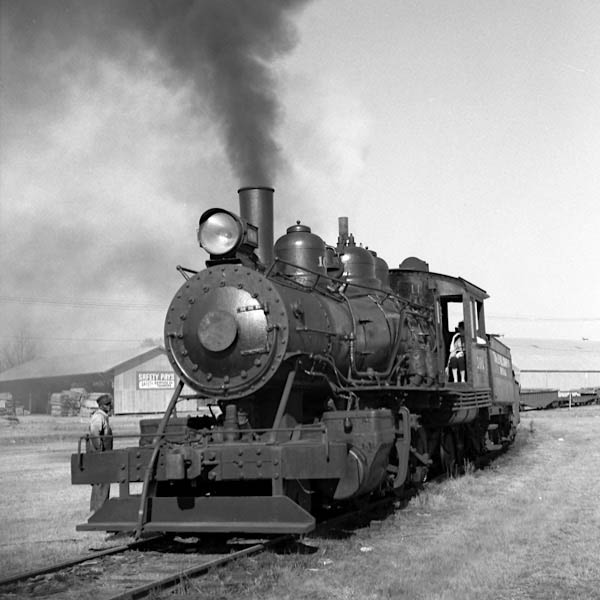
Brewton, Al / Feb 1961 / JCH
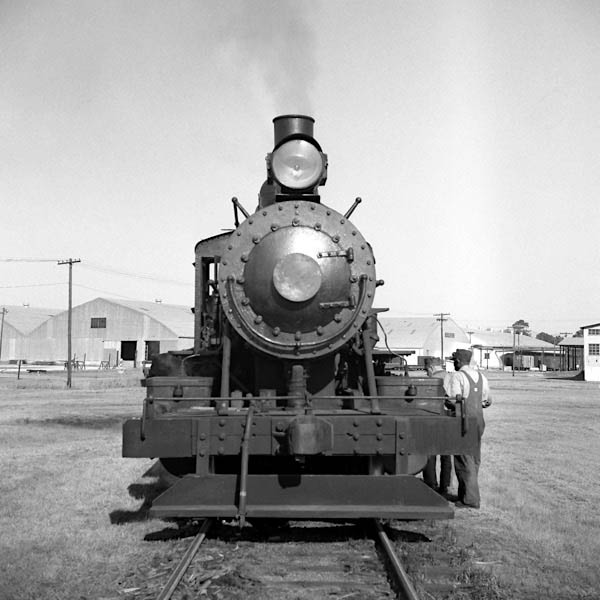
Brewton, Al / Feb 1961 / JCH
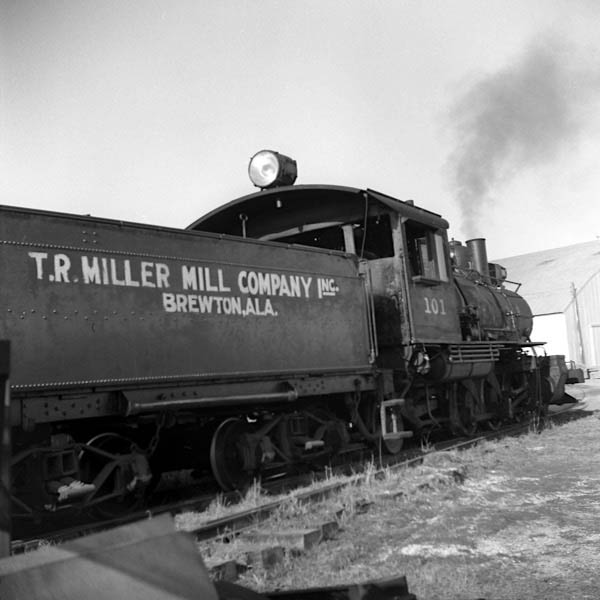
Brewton, Al / Feb 1961 / JCH
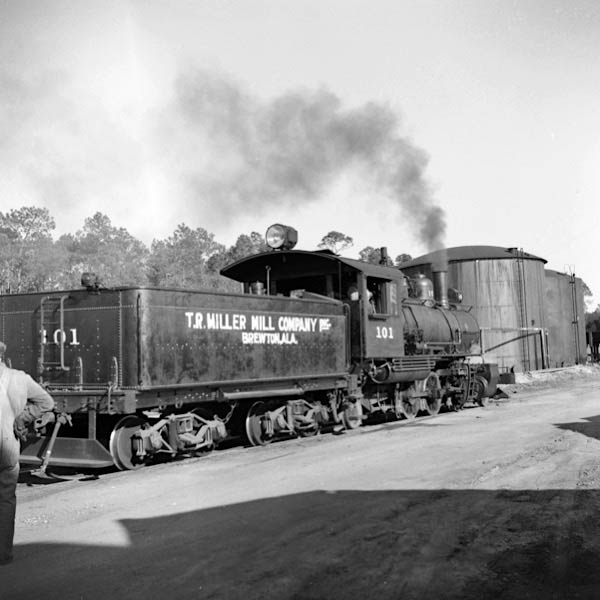
Brewton, Al / Feb 1961 / JCH

Brewton, Al / Feb 1961 / JCH
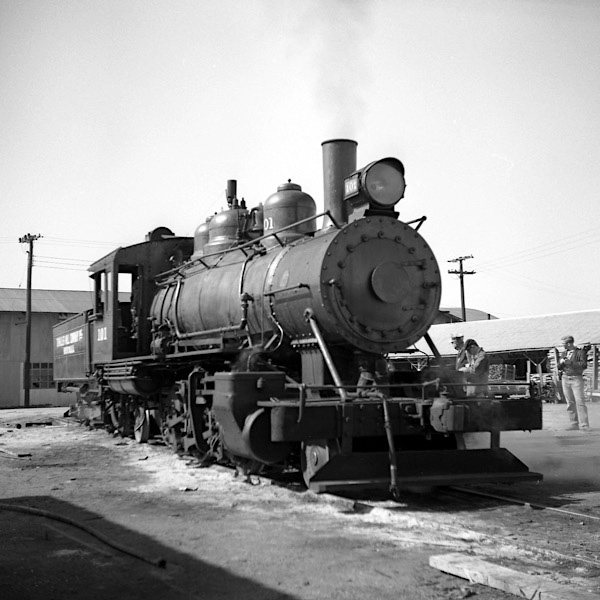
Brewton, Al / Feb 1961 / JCH

See also our complete T R Miller Mill industrial scrapbook for more 101 pictures
HawkinsRails thanks Brian Rucker for use of the images below from his personal collection

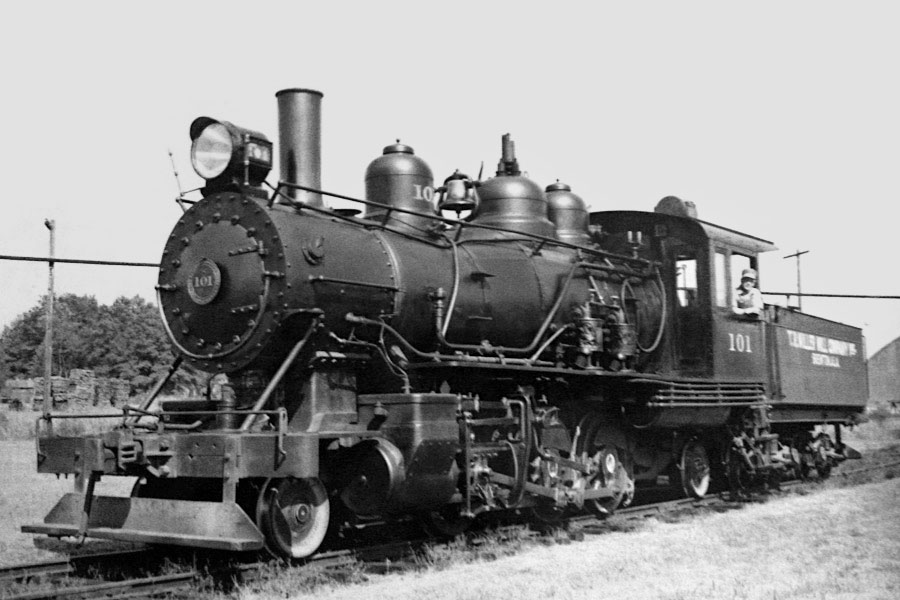
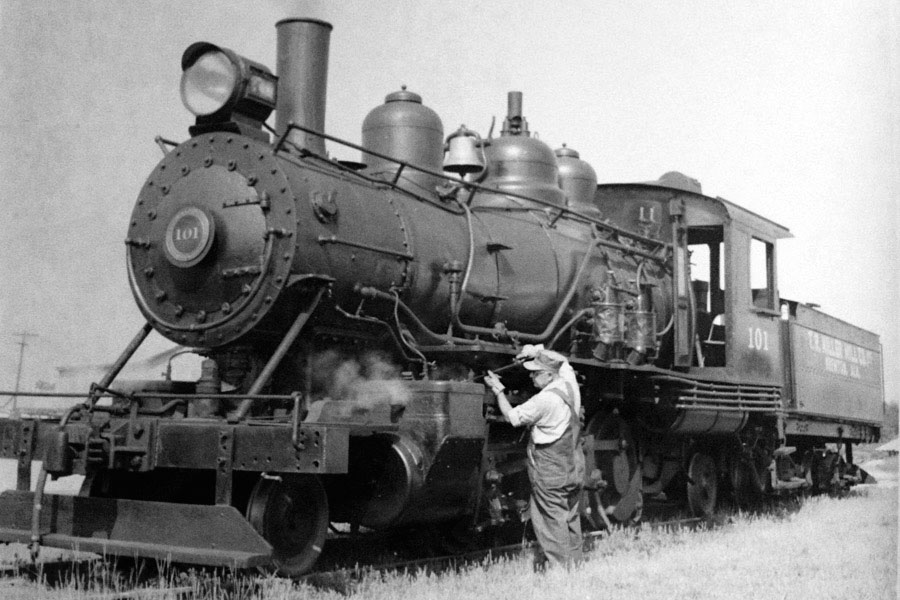
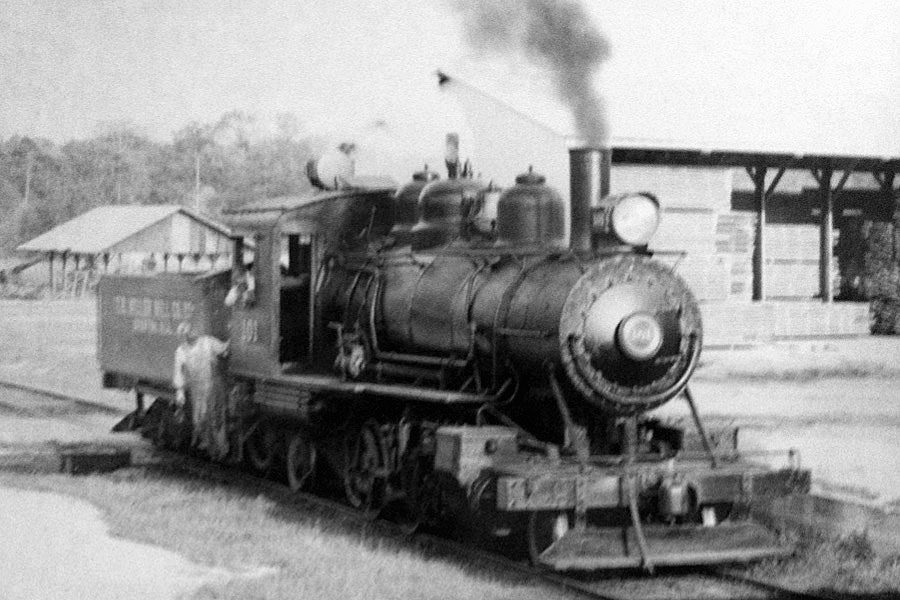




Pilgrimage 101
 In the fall of 2009, my family traveled to Chicago to visit close friends. This being my first visit to Chicagoland by car, I insisted upon a day in the schedule to visit the impressive Illinois Railway Museum. For many years it has been goal of mine to see their fine collection, but in truth two Deep South pieces on the site drew me on a must-see pilgrimage: Columbus & Greenville #606 and T.R. Miller Mill Co. diminutive #101. The IRM is a massive museum, covering lots of ground, so it took me the better part of the morning to find the little engine. Turns out she's stored in two parts: Her boiler and running gear are inside one of the covered buildings, while her tender resides outside in a long cut of rusting steam parts. All in all, I found the engine in rough shape, but not beyond rebuilding. At least her boiler is protected from the weather. The engine is lettered for the Tuskegee Railroad, the other Alabama shortline to own and operate her. Out in Union, Illinois, far northwest of the city, she's a long way from the humid grounds of her Southland home. Still, after spending so much time with dad's 120 negatives, and hearing his several stories of seeing her run and meeting her people, it was good to meet this little Baldwin face to face.
In the fall of 2009, my family traveled to Chicago to visit close friends. This being my first visit to Chicagoland by car, I insisted upon a day in the schedule to visit the impressive Illinois Railway Museum. For many years it has been goal of mine to see their fine collection, but in truth two Deep South pieces on the site drew me on a must-see pilgrimage: Columbus & Greenville #606 and T.R. Miller Mill Co. diminutive #101. The IRM is a massive museum, covering lots of ground, so it took me the better part of the morning to find the little engine. Turns out she's stored in two parts: Her boiler and running gear are inside one of the covered buildings, while her tender resides outside in a long cut of rusting steam parts. All in all, I found the engine in rough shape, but not beyond rebuilding. At least her boiler is protected from the weather. The engine is lettered for the Tuskegee Railroad, the other Alabama shortline to own and operate her. Out in Union, Illinois, far northwest of the city, she's a long way from the humid grounds of her Southland home. Still, after spending so much time with dad's 120 negatives, and hearing his several stories of seeing her run and meeting her people, it was good to meet this little Baldwin face to face.
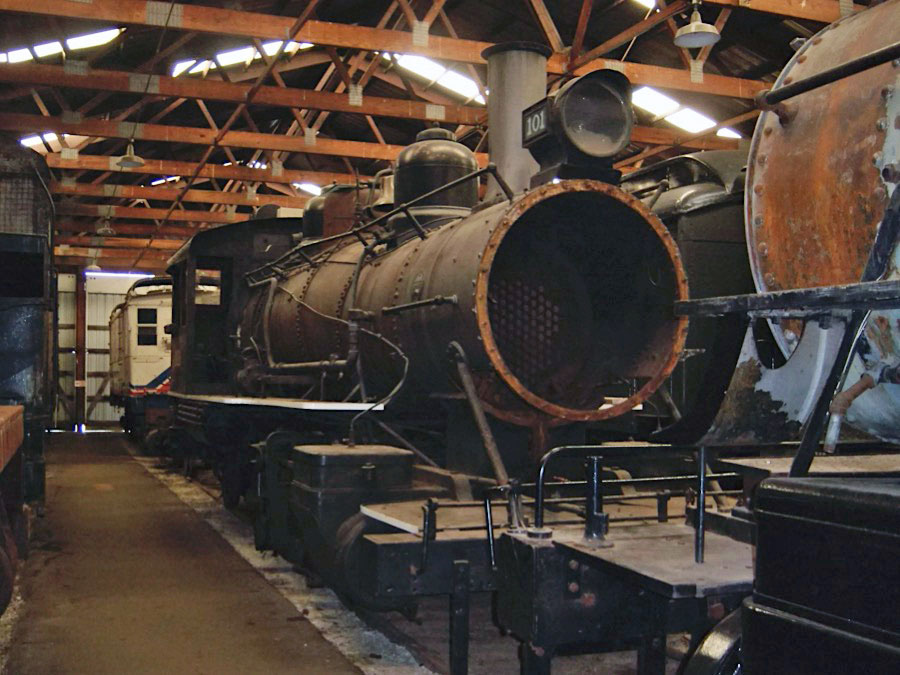
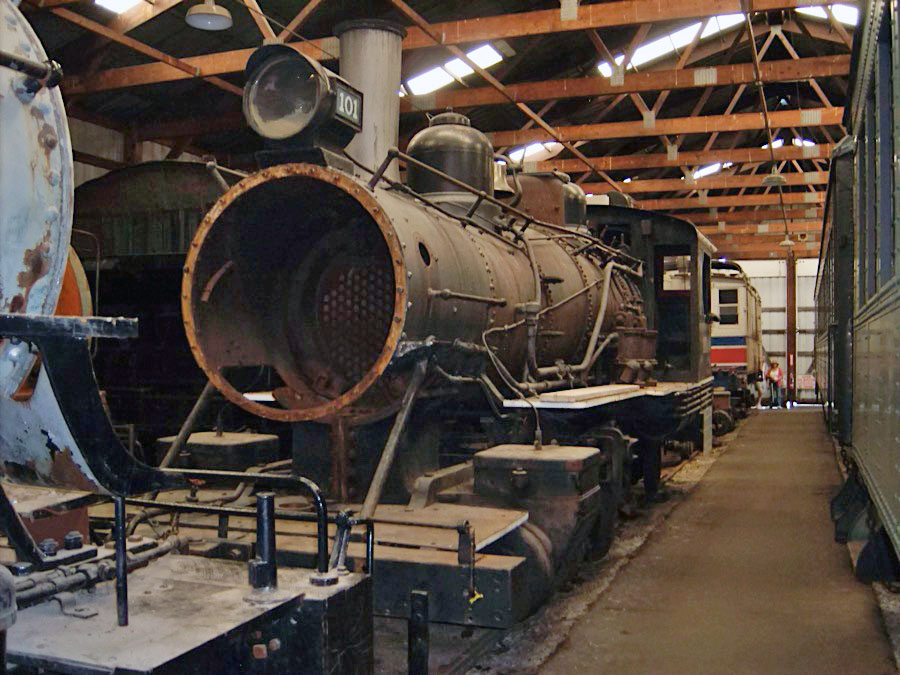
details

See also our complete Illinois Railway Museum scrapbook in Preservation
all photos above: Illinois Railway Museum / Union, Il / Sep 2009 / RWH

